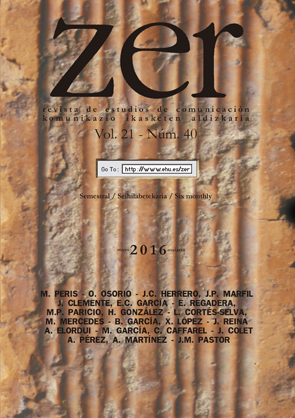El perdón como estrategia de restauración de la imagen: el caso del rey Juan Carlos
##plugins.themes.bootstrap3.article.main##
##plugins.themes.bootstrap3.article.sidebar##
Publicado
27-05-2016
Julio César Herrero
J. Pedro Marfil Medina
Resumen
Juan Carlos I sufrió un accidente en Botsuana en 2012 mientras estaba de cacería. El suceso tuvo un gran impacto en la opinión pública española y en la percepción de la monarquía. Este trabajo desarrolla una aproximación al discurso del perdón y un análisis de las palabras de Juan Carlos I en su disculpa, siguiendo la teoría de restauración de la imagen de William Benoit. El trabajo concluye que el discurso contribuyó a detener la vorágine mediática y a mantener la reputación de la corona y su posible influencia en las estrategias de restauración de imagen de los partidos españoles.
Cómo citar
Herrero, J. C., & Marfil Medina, J. P. (2016). El perdón como estrategia de restauración de la imagen: el caso del rey Juan Carlos. ZER. Revista De Estudios De Comunicación, 21(40). https://doi.org/10.1387/zer.16408
##plugins.themes.bootstrap3.article.details##
References
ABADI, A. (1990). The Speech act of apology in political life. Journal of Pragmatics 14, 467-487.
BENOIT, W. L. (1995) Accounts, excuses, and apologies: A theory of image restoration strategies. New York. SUNY Press.
BENOIT, W. L. (1997). Image repair discourse and crisis communication. Public Relations Review 23, 177-186
BURKE, K. (1970). The rethoric of religion. Berkeley, University of California Press.
BURNS, J., BRUNER, M. (2000). Revisiting the theory of image restoration strategies. Communication Quarterly 48, 27-39
GONZALES, M. PEDERSON, J., MANNING, D., WETTER, D. (1990). Pardon My Gaffe: Effects of Sex, Status, and Consequence Severity on Accounts. Journal of Personality and Social Psychology. 58 (4). 610-621
HANSSON, Sten. (2015). Discursive strategies of blame avoidance in government: A framework for analysis. Discourse & Society. 26 (3) Pp. 1-26
HODGINS, Holley y LIEBESKIND, Elizabeth. (2003). Apology Versus Defense: Antecedents and Consequences. Journal of Experimental Social Psychology 39(4), 297–316.
KRUSE, N. W. (1977). Motivational factors in non-denial apología. Central states speech journal 28, 13-23.
MILLS, N. (2001). The New Culture of Apology. Dissent (Fall) 48(4), 113–116.
RYAN, H.R. (1982). Kategoria and Apogia: On Their Rhetorical Criticism as a Speech Set. Quarterly Journal of Speech 68, 256-261.
SCHLENKER, B. R. (1980), Impression management: the self concept, Social identity, and interpersonal relations. Monterey, CA: Brook/Cole.
SCHÖNBACH (1980). A category system for account phases. European Journal of Social Psychology 10, 195-200.
SCOTT, M. H., and LYMAN, S. M. (1968). Accounts. American sociological review, 33, pp 46-62.
SEMIN, G. R., and MANSTEAD, A. S. R. (1983). The accountability of conduct: a social psychological analysis. London: Academic Press.
SYKES, G. M., and MATZA, D. (1957) Techniques of neutralization: A theory of delinquency. American Sociological Review, 22. 664-670.
TEDESCHI, J. T., and REISS, M. (1981). Verbal strategies in impression management. In C. Antaki (Ed.), The Psychology of ordinary explanations of social behaviour (pp. 271-326). London: Academic Press.
THOMPSON, John B. (2000): Political Scandal. Power and Visibiliry in the Media Age, Oxford, Polity Press. [Ed. cast.: El escándalo político: poder y visibilidad en la era de los medios de comunicación, Barcelona, Paidós, 2000]
TUCKER, S. Et al. (2006) Apologies and Transformational Leadership. Journal of business ethics. 63 (2), 195-207
WARE, B. & LINKUGEL, W. (1973) They spoke in defense of themselves: On the generic criticism of apología. Quarterly Journal of Speech 59, 273-283.
BENOIT, W. L. (1995) Accounts, excuses, and apologies: A theory of image restoration strategies. New York. SUNY Press.
BENOIT, W. L. (1997). Image repair discourse and crisis communication. Public Relations Review 23, 177-186
BURKE, K. (1970). The rethoric of religion. Berkeley, University of California Press.
BURNS, J., BRUNER, M. (2000). Revisiting the theory of image restoration strategies. Communication Quarterly 48, 27-39
GONZALES, M. PEDERSON, J., MANNING, D., WETTER, D. (1990). Pardon My Gaffe: Effects of Sex, Status, and Consequence Severity on Accounts. Journal of Personality and Social Psychology. 58 (4). 610-621
HANSSON, Sten. (2015). Discursive strategies of blame avoidance in government: A framework for analysis. Discourse & Society. 26 (3) Pp. 1-26
HODGINS, Holley y LIEBESKIND, Elizabeth. (2003). Apology Versus Defense: Antecedents and Consequences. Journal of Experimental Social Psychology 39(4), 297–316.
KRUSE, N. W. (1977). Motivational factors in non-denial apología. Central states speech journal 28, 13-23.
MILLS, N. (2001). The New Culture of Apology. Dissent (Fall) 48(4), 113–116.
RYAN, H.R. (1982). Kategoria and Apogia: On Their Rhetorical Criticism as a Speech Set. Quarterly Journal of Speech 68, 256-261.
SCHLENKER, B. R. (1980), Impression management: the self concept, Social identity, and interpersonal relations. Monterey, CA: Brook/Cole.
SCHÖNBACH (1980). A category system for account phases. European Journal of Social Psychology 10, 195-200.
SCOTT, M. H., and LYMAN, S. M. (1968). Accounts. American sociological review, 33, pp 46-62.
SEMIN, G. R., and MANSTEAD, A. S. R. (1983). The accountability of conduct: a social psychological analysis. London: Academic Press.
SYKES, G. M., and MATZA, D. (1957) Techniques of neutralization: A theory of delinquency. American Sociological Review, 22. 664-670.
TEDESCHI, J. T., and REISS, M. (1981). Verbal strategies in impression management. In C. Antaki (Ed.), The Psychology of ordinary explanations of social behaviour (pp. 271-326). London: Academic Press.
THOMPSON, John B. (2000): Political Scandal. Power and Visibiliry in the Media Age, Oxford, Polity Press. [Ed. cast.: El escándalo político: poder y visibilidad en la era de los medios de comunicación, Barcelona, Paidós, 2000]
TUCKER, S. Et al. (2006) Apologies and Transformational Leadership. Journal of business ethics. 63 (2), 195-207
WARE, B. & LINKUGEL, W. (1973) They spoke in defense of themselves: On the generic criticism of apología. Quarterly Journal of Speech 59, 273-283.
Número
Sección
Artículos
(c) UPV/EHU Press

